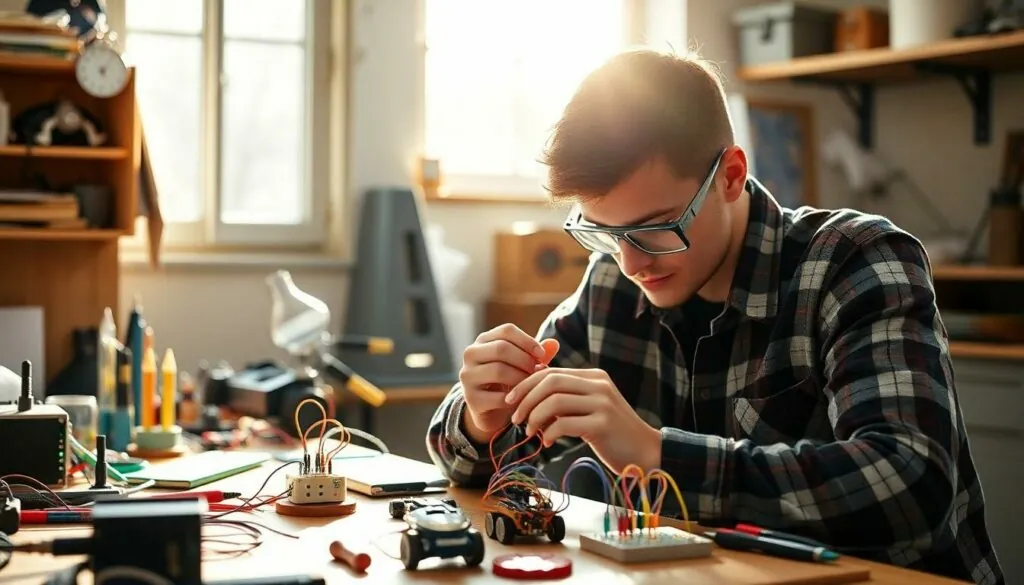In a world where gadgets reign supreme, why not take matters into your own hands? DIY gadgets offer a thrilling blend of creativity and functionality, transforming everyday tasks into fun projects. Imagine crafting your own smart home devices or building a quirky robot that serves snacks at your next party. Who wouldn’t want a gadget that’s not only useful but also a conversation starter?
The beauty of DIY gadgets lies in their accessibility. With just a few tools and a sprinkle of imagination, anyone can dive into the world of tech innovation. Whether you’re a seasoned tinkerer or a curious newbie, there’s a DIY project waiting to spark your interest. So roll up those sleeves and prepare to impress your friends with gadgets that scream “I made this!” Get ready to unleash your inner inventor and discover the joy of creating something uniquely yours.
Table of Contents
ToggleOverview of DIY Gadgets
DIY gadgets present an exciting blend of creativity and practicality. They allow individuals to transform mundane tasks into engaging projects. Crafting these devices encourages innovation and skill development. Examples include smart home devices that improve home automation and fun robots that entertain while teaching programming basics.
Various materials can be utilized, from recycled components to modern electronic parts, making these projects accessible to many. Enthusiasts learn to work with tools such as soldering irons and 3D printers, which enhances their technical abilities.
Moreover, the online community for DIY gadgets thrives, providing endless resources like tutorials, videos, and forums for sharing ideas. This support enhances confidence and inspires experimentation among both beginners and experts.
Building personalized gadgets fosters a sense of ownership and pride. Achieving functional devices that fit individual needs delivers satisfaction that store-bought gadgets can’t replicate.
Overall, the world of DIY gadgets invites creativity and problem-solving. It embraces all skill levels, motivating individuals to unleash their inventiveness. Engaging in these projects cultivates a sense of accomplishment that resonates beyond the final product.
Popular Types of DIY Gadgets

DIY gadgets encompass a variety of categories that cater to different interests and skill levels. Each type offers unique opportunities for creativity and functionality.
Electronics Projects
Electronics projects involve creating devices using circuits and components. Examples include building a custom LED lamp, designing a portable speaker, or assembling a microcontroller-based robot. With the availability of online resources, individuals can find numerous tutorials for all skill levels. Components such as Arduino boards and Raspberry Pi units provide endless possibilities for innovation. Successful projects often incorporate code to enhance functionality, making them both educational and enjoyable.
Home Automation Devices
Home automation devices transform ordinary living spaces into smart environments. Notable examples include smart light switches, automated blinds, and self-watering plant systems. Creating such gadgets typically requires minimal components like sensors and microcontrollers. Additionally, software integration allows users to control devices through smartphones or voice assistants. Implementing these gadgets often enhances convenience, security, and energy efficiency in the home.
Creative Tool Hacks
Creative tool hacks reimagine existing tools to improve their functionality or versatility. Common projects include converting a regular drill into a paint mixer or modifying a ladder for increased stability. Inventive modifications can simplify tasks and save time, making everyday activities more efficient. By using materials such as PVC pipes or scrap wood, individuals can often craft unique solutions. Innovative tool hacks inspire problem-solving and encourage resourcefulness among creators.
Benefits of DIY Gadgets
DIY gadgets offer numerous benefits that appeal to hobbyists and innovators alike. From personal satisfaction to practical advantages, engaging in these projects can transform how individuals approach technology.
Cost Savings
Creating DIY gadgets often leads to significant cost savings. Individuals can craft devices using readily available materials and components, reducing expenses compared to purchasing similar products. Custom devices often require unique parts, which may be sourced at a lower price than mass-produced items. Savings multiply when individuals repurpose old gadgets or materials instead of buying new ones, making it a budget-friendly option. Investing time in DIY projects can yield functional gadgets at a fraction of retail prices.
Skill Development
Engaging in DIY gadget projects enhances various skills. Individuals improve technical abilities by working with electronics, coding, and design principles. These projects require problem-solving, critical thinking, and creativity, encouraging personal growth. Individuals often discover new interests in fields such as electronics, programming, or woodworking through experimentation. Mastering tools like soldering irons or 3D printers fosters both confidence and competency, ultimately leading to more advanced projects. Learning becomes enjoyable, making the experience rewarding beyond just the finished gadget.
Getting Started with DIY Gadgets
Starting with DIY gadgets requires minimal tools and creativity. Engaging in these projects balances fun with functionality.
Tools and Materials Needed
Essential tools include soldering irons, wire strippers, and pliers. These items enable precise assembly of components. For beginners, a basic toolbox suffices. Common materials consist of microcontrollers, wires, and recycled electronics. Creating simple projects from old gadgets proves cost-effective. Furthermore, a 3D printer allows for custom part creation. Several online resources provide detailed lists tailored to specific projects. Preparing a workspace with adequate lighting and organization enhances efficiency.
Finding Inspiration and Ideas
Discovering inspiration for DIY gadgets can stem from various sources. Online tutorials and forums offer extensive examples to explore. Maker communities on social media showcase innovative projects. Home automation guides spark creativity and introduce practical applications. Visiting local maker fairs also provides exposure to current trends and technologies. Identifying everyday challenges can lead to unique solutions. Following popular DIY blog channels expands the range of ideas. Experimenting with personal interests fuels enthusiasm and innovation.
DIY gadgets offer a unique blend of creativity and practicality that empowers individuals to innovate and solve everyday challenges. By engaging in these projects, creators can enhance their technical skills while enjoying the process of making something truly personal. The accessibility of materials and tools makes it easy for anyone to jump in, regardless of experience level.
As the DIY community continues to grow, the wealth of resources available online ensures that inspiration is just a click away. Whether it’s building smart home devices or reimagining existing tools, the journey of crafting DIY gadgets is rewarding. Embracing this hands-on approach not only leads to cost savings but also fosters a sense of accomplishment that enhances personal growth.



